VS125-L0BEU Custom Profile Template
This topic describes how to create a custom Profile template for VS125-L0BEU.
Background information
A Profile template contains both Basic Settings and Advanced Settings. Basic settings can edited with the visual interface provided by Milesight Development Platform, while the advanced settings can ONLY be edited in JSON format.
Follow the workflow below to create and apply a custom Profile template:
- Create a custom Profile template on Milesight Development Platform.
- Configure the basic settings with the visual interface.
- Configure the advanced settings in the JSON format.
- Save and apply the custom Profile template accordingly.
Step 1. Create a custom Profile template
- Log in to Milesight Development Platform.
- On the top bar, click Resource,
then select the My Config
tab.

- Click Add.
- In the Basic Configuration section, configure the
basic information:

- In the Config Template Name field, specify a name to help you identify this template.
- In the Select Product Config Template field, search and select VS125-L0BEU_Profile_Template.
- In the Config Template Version drop-down list, select the version of the Profile template.
Step 2. Configure the connecting platform
- Select the Generic Configuration tab.
- In the Device Management Connections section, decide
whether to connect the device to Milesight platform for remote management
and configuration.
- Connect the device to Milesight Development Platform
- Retain the default settings.
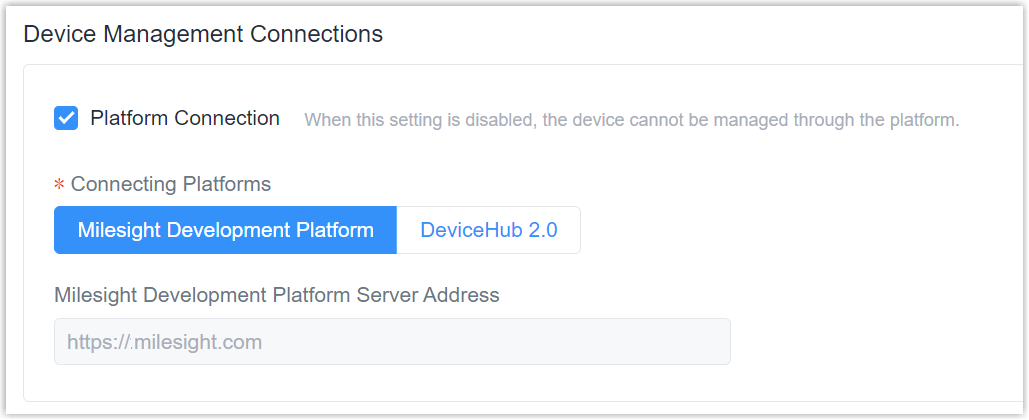
- Connect the device to Milesight DeviceHub
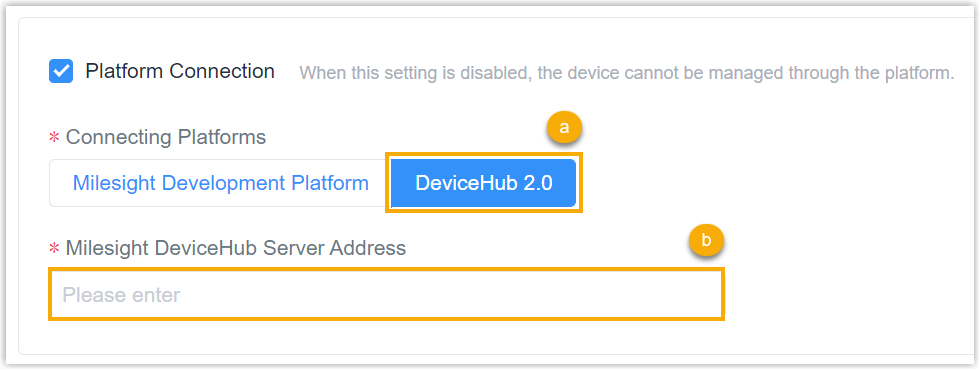
- In the Connecting Platforms field, select DeviceHub 2.0.
- In the Milesight DeviceHub Server Address field, enter the server address of the Milesight DeviceHub.
- Do NOT connect to Milesight platform
- Uncheck the Platform Connection.

Step 3. Configure the Dashboard settings
- Select the Basic Configuration tab, then go to the
Dashboard section.
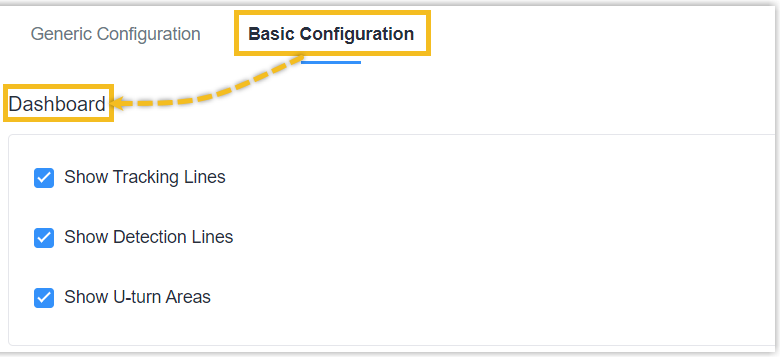
-
Specify the relevant areas show of the detected function by clicking the checkbox.

Step 4. Configure the Function Rule
- In the Rule section, specify corresponding
rules.
Setting Description Installation Height To set the device installation height. Maximum Target Height To set the maximum target height, then the device will ignore the objects higher than this setting value.
Minimum Target Height To set the minimum target height, then the device will ignore the object shorter than this setting value.
Tracking To specify tracking mode of counting. Head Tracking and Feet Tracking are optional. Note:- It is recommended to use heads tracking mode when the installation height is low.
U-turn Filtering Click to enable U-turn Filtering, which will count the In and Out values only when people passed the U-turn area for every line.
Children/Adults Differentiation Child Filter Height: To set the max child height when children distinction feature is enabled.
And then the device will detect the people shorter than child filter height as children.
Gender Detection Click to detect the gender of people.
Region Monitoring Click to enable the region monitoring. Up to 4 regions are supported with maximum 10 segments each.
Reset Cumulative Count on Schedule Click to enable periodically reset cumulative count on schedule.
Cumulative Count includes:
- Total In/Out counting of each detection line.
- Max./Avg. Dwell Time of each detection region.
Step 5. Configure the Network settings
- In the Network section,
configure the cellular settings.
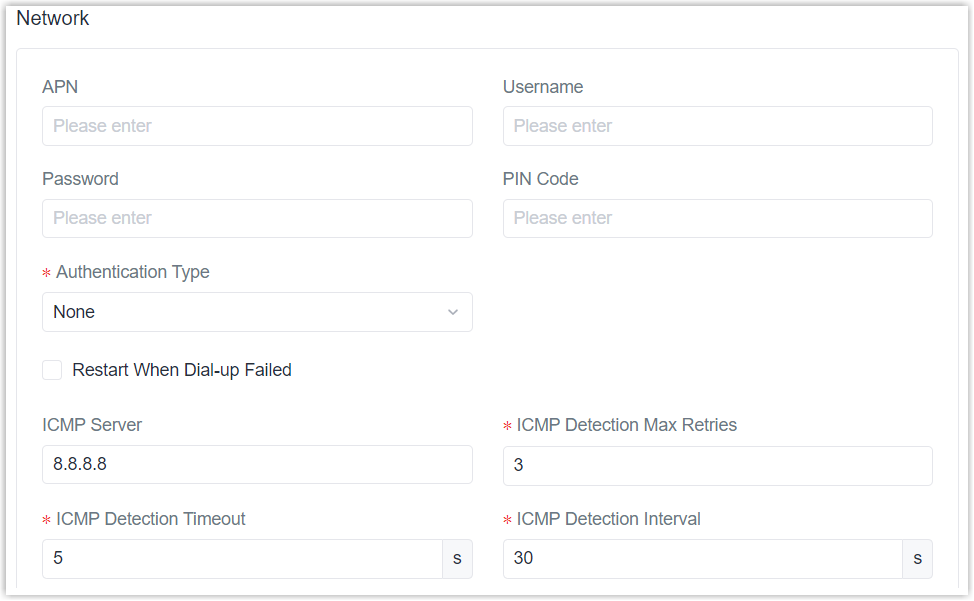
Setting Description APN Specify the Access Point Name for cellular dial-up connection provided by local ISP. Please contact cellular operator or search for the Internet to get it.
Username Specify the username for cellular dial-up connection provided by local ISP.
Password Specify the password for cellular dial-up connection provided by local ISP. PIN Code Specify a 4-8 characters PIN code to unlock the SIM. Authentication Type Select the Authentication Type. None, PAP, CHAP are optional.
Restart When Dial-up Failed Enable or disable automatic device restart when multiple dial-up failed.
ICMP Server The device will send ICMP packet to this server address to determine whether the Internet connection is still available or not.
ICMP Detection Max Retries The number of times the device will retry sending a ping request until determining that the connection has failed. (Unit: s)
ICMP Detection Timeout The maximum time which the device will wait for a response to a ping request. If it does not receive a response for the timeout, the ping request will be considered to have failed. (Unit: s)
ICMP Detection Interval Time interval between two Pings. (Unit: s)
- In the Enable WLAN section,
specify whether to enable WLAN by checking the checkbox and configure the
WLAN AP settings for local web access and configuration.

Setting Description Wi-Fi SSID The unique name for this device Wi-Fi access point. Protocol Select the protocol for Wi-Fi connection.
Bandwidth Select the bandwidth for Wi-Fi connection. Channel Select the channel for Wi-Fi connection. Security Mode Select the security mode for Wi-Fi connection.
Step 6. Configure the Recipient settings
- Go to the Recipient Settings section, then click
Add+ to add the recipients of device.

- In the Recipient section, specify the data receivers.
The device will proactively push data to the receivers according to the
configured reporting scheme.Note:
- Up to 8 receivers can be added.
Setting Description Name Customize the recipient name.
Report Protocol HTTP(S) To set the reporting protocol as HTTP(S), do as follow: - Select HTTP(S) report protocol.
- Configure the HTTP(S) information as needed.
MQTT To set the reporting protocol as MQTT, do as follow: - Select MQTT report protocol.
- Configure the MQTT information as needed or retain the default value.
- In the TLS Type field,
click to enable and specify the certificate type
for TLS.
- To use the CA-signed TLS certificate, select CA Signed Server.
- To use Self-signed TLS certificate, select Self Signed and upload the required certificate files.
Trigger Report Report immediately when there is a change of the line crossing people counting number or region people counting number.
Periodic Report Select the periodic report of "On the Dot" or "From Now On". On the Dot: The device will report at the top of each hour. For example, When the interval is set to 1 hour, it will report at 0:00, 1:00, 2:00 and so on; when the interval is set to 10 minutes, it will report at 0:10, 0:20, 0:30, and so on.
From Now On: Begin reporting from this moment onwards and regularly report based on the interval cycle.
Data Retransmission Click to enable resend stored data packets from the disconnected period when the device's network connection is restored.Note: A maximum of for each recipient can be resent.Device Info Customizable selection of content to be reported, avoiding data redundancy.
Line Trigger Data Region Trigger Data Line Periodic Data Line Total Data Region Period Data Line/Region Name Line/Region UUID
Step 7. Configure the MQTT API Settings
- Go to the MQTT API Settings section to configure MQTT
API settings as required.

- Configure the MQTT information as needed or retain the default value.
- In the TLS Type field, click to enable and
specify the certificate type for TLS.
- To use the CA-signed TLS certificate, select CA Signed Server.
- To use Self-signed TLS certificate, select Self Signed and upload the required certificate files.
Step 8. Configure Image settings
- Go to the Image Settings section, Specify the
day/night switch mode of the device.
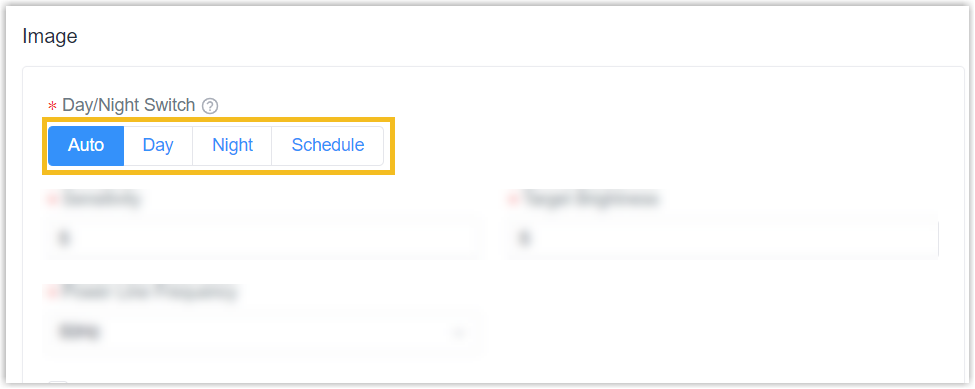
The device supports 4 image display modes:
Setting Description Auto Automatic switch day and night according to image brightness.
Sensitivity: the higher sensitivity, the easier to switch day and night.
Day Black and white mode.
Night Infrared based black and white mode.
Schedule Switch day and night according to the configured schedule.
- Specify the day/night switch mode of the device and configure the
parameters.
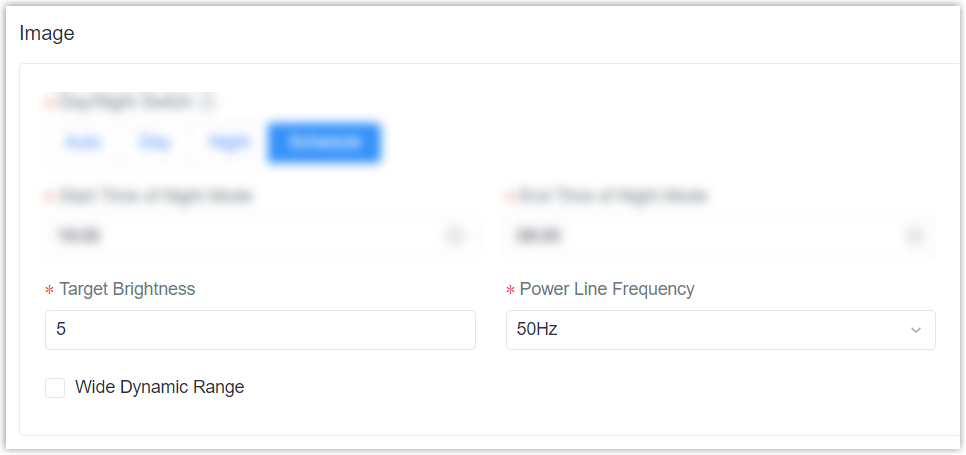
Setting Description Target Brightness Set the brightness of the target to make image clearer. The higher brightness is, the brighter the target brightness is.
Power Line Frequency Choose the frequency to avoid the image flashing.
Wide Dynamic Range Enable WDR to capture more detail in scenes where light conditions vary greatly.
Step 9. Configure the System Settings
- Go to the System Settings section.
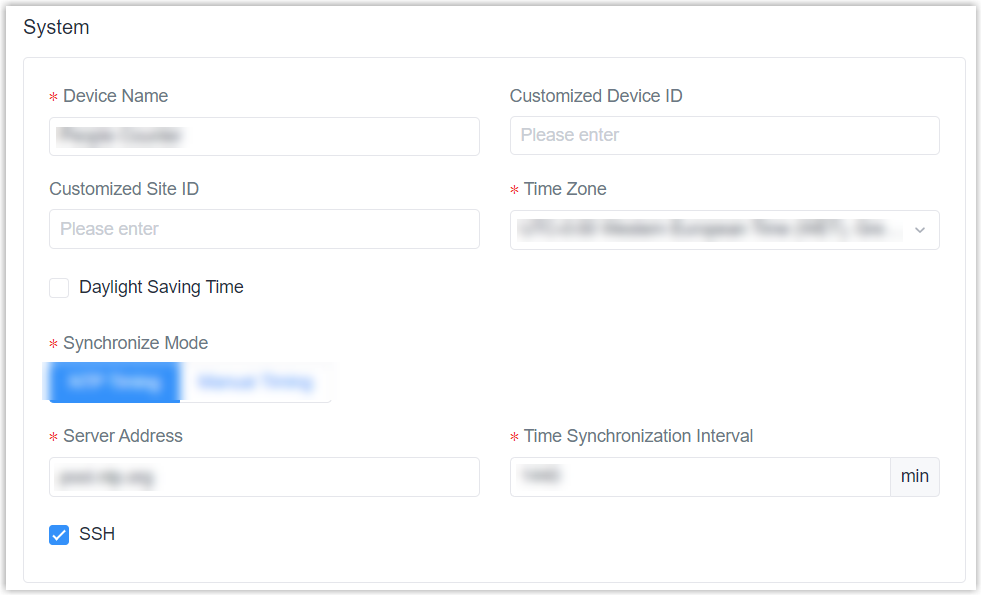
- In the Device Name field, specify a name to help you identify this device.
- You can specify a Device ID and a Site ID for this device as needed.
- In the Time Zone drop-down list, select the desired time zone for this device.
- In the Daylight Saving Time field, decide whether to
enable Daylight Saving Time (DST) for this device.
- Off: Disable DST for this device.
- Automatic: Enable DST for this device.
- In the Time Synchronize Mode section, specify the
time synchronization mode.
- Manual: Manually synchronize the device's time.
- NTP Timing: Synchronize the device's time
across a network using the Network Time Protocol.
You can specify the Server Address and Time Synchronization Interval as needed.
- In the SSH field, decide whether to enable SSH service for this device.
Step 10. Save the custom Profile template
- On the left-bottom of the page, click Save.
- Apply the custom Profile template according to the operation method.
- Web page: Select the Profile template when adding devices.
- API: Do as follow:
- In the Operation column, click
 to download the Profile in
JSON.
to download the Profile in
JSON.
- Include the entire JSON in the API request of Add a Device.
- In the Operation column, click